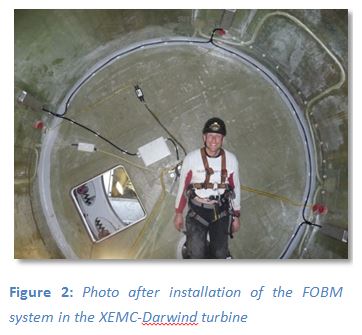
◀ Back to projects overview P201102-003-ECN
Blade Load Monitoring based on Fiber Optic Measurements (BLM-FO)
Public Summary
Operation and Maintenance (O&M) costs of an offshore wind farm are currently very high; the relative contribution of O&M to the kWh price can amount to 25-30%. A blade load monitoring system can enable a shift from a reactive to a proactive maintenance approach. A shift to a proactive approach, where maintenance is performed based on the condition of the components of the turbine, offers great costs savings potentials. Components can be replaced prior to failures, hence reducing the downtime of the wind turbines and increasing the energy yield of the power plant.
A blade load monitoring system also offers great costs savings when using the measured loads for controlling a wind turbine. An advanced controller can reduce fatigue loads, reduce the number of shutdowns and reduce extreme loads on tower and blades.
Optical sensors can be applied for loads control and O&M optimization since they are more reliable and stable throughout the turbine lifetime.
As part of the Far and Large Offshore Wind (FLOW) innovation program, ECN together with industry partners 2-B Energy and XEMC-Darwind executed the FLOW project P201102_003 Development and demonstration of Blade Load Monitoring based on Fiber Optic Measurements with the objective to further develop the prototype of the Fibre Optic Blade load Monitoring (FOBM) system and make it ready for series production. The main project objectives were:
A. Reduction of the costs of the load monitoring system.
B. Optimisation of software for data acquisition, data processing and reporting to provide operators with information relevant for O&M optimisation.
C. Installation and demonstration of the system on the XEMC-DARWIND and the 2-B Energy turbine
D. Demonstration of the added value of a blade load monitoring system for condition based maintenance and optimization of O&M procedures resulting in reduced LCoE (Levelized Cost of Energy) for offshore wind energy.
E. Investigation of benefits of a blade load monitoring system for other applications like individual pitch control (IPC), load control and substructure measurements.
The FLOW BLM-FO project was executed through seven Work Packages (WP’s):
- WP’s 1-3 focus on further development of the FOBM system focussing on the sensor assembly, read out unit, data acquisition and processing software.
- WP’s 4-5 focus on the demonstration and optimization of the technology in the field.
- WP 6 investigates the added value of load monitoring and individual pitch control.
- And WP 7 focusses on the testing of the sensor in the laboratory, a full scale blade test and testing the FOBM software.
Project results
The following main results are obtained through this research project:
- ECN’s load monitoring system (FOBM) is further developed and demonstrated. The results and findings were disseminated and have lifted the state-of-the-art of optical sensing technologies. Based on extensive laboratory tests and the successful demonstration in the 5MW wind turbine of XEMC-Darwind, the technology of the FOBM system has matured and is ready for the final steps: industrialization and commercialization.
The project resulted in the following spin-off:
- A consortium has been created to commercialize the FOBM system, with Adwen (joint venture of Areva and Gamesa) as leading partner.
- As a result of the project ECN has started a R&D project with a large wind turbine manufacturer and has installed the FOBM system in a 2MW turbine in China in October 2015.
- In 2015 the TKI-project JIP-MONITOR has been started, in which ECN in cooperation with TNO and with the support of industrial partners (Gemini, Van Oord, Keppel Verolme, and Mecal) will develop a monitoring system for sub-structures.
Contribution to cost and risk reduction of far-offshore wind energy
Together with other FLOW project Fleet Leader (P201102_002) case studies have been performed to quantify the potential costs savings. Using the FLOW cost model, the project deliverables contribute to cost reduction of 9.05% on the costs of O&M for offshore wind farms. The calculated expected cost reduction associated with this results in approximately 1.16% cost reduction. A shift from corrective maintenance to condition based maintenance by load monitoring will reduce the risk of downtime and high repair cost due to unexpected failures. The cost and risk reduction will accelerate the deployment of far offshore wind energy.
Presentation
![]() Windkracht 14: Health monitoring
Windkracht 14: Health monitoring
Links
Flyer Fibre Optic Blade Load Monitoring (FOBM)
Leaflet Fiber Optic Load Monitor of Windturbines
Paper presented at the European Wind Energy Conference 2004
Partners involved
- 2-B Energy
- ECN
- XEMC-Darwind
Contact details
Mr. Toine Curvers
Project documents
![]() Potential cost reduction FOBM assembly
Potential cost reduction FOBM assembly
![]() Kick-off blade load monitoring
Kick-off blade load monitoring
![]() Installation manual optical sensors
Installation manual optical sensors
![]() FOBM specifications diagnostic software
FOBM specifications diagnostic software

 Share this page
Share this page
